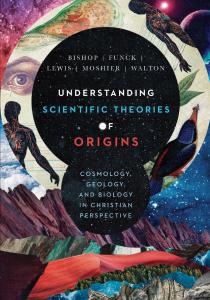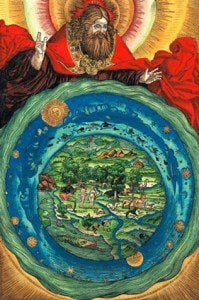 Consider Genesis 1.
Consider Genesis 1.
In the beginning when God created the heavens and the earth, the earth was a formless void and darkness covered the face of the deep, while the spirit of God swept over the face of the waters. Then God said, “Let there be light”; and there was light. And God saw that the light was good; and God separated the light from the darkness. God called the light Day, and the darkness he called Night. And there was evening and there was morning, the first day.
 Here begins, so we assume, an account of the material origins of the universe. But this may be a serious misunderstanding of the intent of the original author and thus the intent of God’s revelation through Scripture. In Chapter 5 of Understanding Scientific Theories of Origins John Walton has argued at length that in the opening chapter of Genesis God is ordering the cosmos and creating sacred space. He is establishing his temple in which he will dwell. (See Genesis 1 as Ancient Cosmology and The Lost World of Genesis One.) In this chapter John summarizes the major points of his argument.
Here begins, so we assume, an account of the material origins of the universe. But this may be a serious misunderstanding of the intent of the original author and thus the intent of God’s revelation through Scripture. In Chapter 5 of Understanding Scientific Theories of Origins John Walton has argued at length that in the opening chapter of Genesis God is ordering the cosmos and creating sacred space. He is establishing his temple in which he will dwell. (See Genesis 1 as Ancient Cosmology and The Lost World of Genesis One.) In this chapter John summarizes the major points of his argument.
There is no argument that the Bible portrays God as the creator of everything that exists. That God is creator is not at question. The question focuses on the specific intent of the creation account in Genesis 1. Does this beautiful and figurative opening to our Bible recount material creation or creation of a different kind? There are several reasons for considering creation with a different focus. A better understanding of the ancient near Eastern cultural context in which the author and original audience lived for one. John Walton has spent decades studying and writing on the ancient context of the Old Testament. The text itself for a second. When it comes to the text itself, The ordering of the days of Genesis 1 has often raised an eyebrow or two. Light is created before the sun or the moon. Day and night, evening and morning, defined by the rotation of the earth, are named in day one but the sun and moon are created on day four. The text is relating something other than a straightforward account of material origins. The strength of the evidence for an ancient earth and the gradual development of life provides a third reason for reexamining the creation narrative, but it is far from the only reason.
The ordering of the cosmos.
On the first day God separates light from dark and names Day and Night. Rather than an account of material origin God is establishing or creating time and order. “Time is related to how our world functions, not its material components. It pertains to how it works, not what it is made of.” (p. 100)
On the second day God causes a dome to separate the waters above from the waters below. John notes that “The space that is set up forms the environment in which we live.” (p. 101) God has ordered the cosmos to produce a living space.
On the third day God gathers the waters, causing land to appear and calls on the land to put forth vegetation. “Again, the focus of the text is not on the origins of the objects (i.e., the material origins) but on setting up order in the cosmos so that it will function for human beings. On day three the focus is on the operations that result in food.” (p. 101) Of course, dry land also provides a space for human to live.
Day four parallels day one. Lights are placed in the vault to “separate the day from the night” and to “be for signs and for seasons and for days and years.” It is also significant that the lights are just that, ordered by God. This is contrary to the cultural view that the sun, moon, and other lights in the sky are divine beings. In Genesis 1 they are simply lights serving a God ordained function in establishing order.
Day five results in the appearance of sea creatures and birds to populate the waters and the sky. “Let the waters bring forth swarms of living creatures, and let birds fly above the earth across the dome of the sky.” (v. 20) God is clearly responsible for the appearance of living creatures including the monsters of the sea, but the emphasis isn’t on material creation. God blessed them, saying, “Be fruitful and multiply and fill the waters in the seas, and let birds multiply on the earth.” (v. 22) Again John suggests that the emphasis is on order and function rather than material origins.
Day six results in the presence of land creatures including human beings. “Day six begins with the decree that the land should produce living creatures (Gen 1:24), and it is by this means that God made the animals (Gen 1:25)” The emphasis is not on a description of the way in which the land produces creatures – any more than the way in which the waters produce sea creatures. When it comes to people, the primary focus is on the role and function of humans in creation.
Then God said, “Let us make humankind in our image, after our likeness, so they may rule over the fish of the sea and the birds of the air, over the cattle, and over all the earth, and over all the creatures that move on the earth.” (v. 26)
John summarizes:
Genesis 1 deals with the question of order and function as [other ancient Near Eastern accounts] do, but it avers that it is Yahweh who has ordered the world as his kingdom and that therefore he rules it. Furthermore, he has done it for the benefit of people and the creation’s sake, not for himself. This differs from the ANE, where the cosmos was ordered for the gods, and people were an afterthought – slave labor to meet the needs of the gods. (p. 103)
It is significant that humans are created (male and female) to be the image and likeness of God in the cosmos with the command to “Be fruitful and multiply, and fill the earth and subdue it” (v. 28) This is a direct and important contrast with the surrounding culture.
 Finally, day seven rolls around. God takes his rest in the cosmos. “God’s rest in the cosmos, his new activity, is a way of expressing his rule over the cosmos.” (p. 111)
Finally, day seven rolls around. God takes his rest in the cosmos. “God’s rest in the cosmos, his new activity, is a way of expressing his rule over the cosmos.” (p. 111)
And on the seventh day God finished the work that he had done, and he rested on the seventh day from all the work that he had done. So God blessed the seventh day and hallowed it, because on it God rested from all the work that he had done in creation. (2:2-3)
In the ancient world, deities rested in temples, and temples were built specifically so deities would rest in them. This rest was not primarily descriptive of relaxation or sleep … More importantly, it expresses how the temples served as the control room of the cosmic domain in the god’s jurisdiction. When gods rested in the temple, they assumed rule over their ordered cosmic domains from their command centers. In the case of Yahweh, his domain is the entire cosmos. This rule is intended to bring stability and smooth functioning to the ordered cosmos. (p. 111)
John emphasizes the importance:
[D]ay seven is the most important day in the account. Without day seven, the other days do not have meaning. God has ordered the cosmos so that it is ready to serve as sacred space in which he takes up his residence to rule over it, preserving its stability and order by his presence. (p. 112)
God is creator of heavens and earth. He alone is responsible for everything in them. Rather than describing material origins however, Genesis 1 relates how God ordered chaotic matter into sacred space, placed humans in it as his image, and took up his residence in and established his rule over the cosmos.
This isn’t a science text, but it is an appropriate beginning to the story of the mission of God related in the Bible.
If you wish to contact me directly you may do so at rjs4mail[at]att.net.
If interested you can subscribe to a full text feed of my posts at Musings on Science and Theology.
















